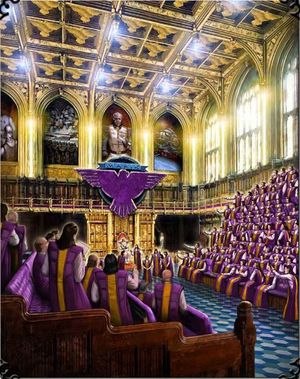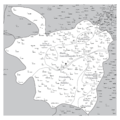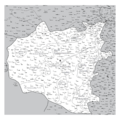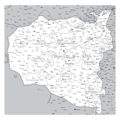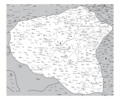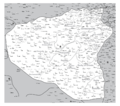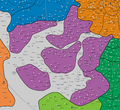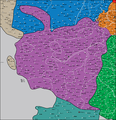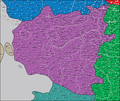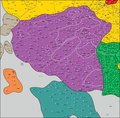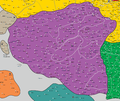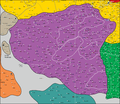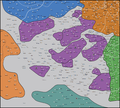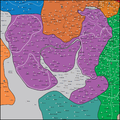Free Worlds League
This article needs to be updated with material from Field Report: FWLM, Era Report: 2750, Empire Alone. Once these titles clear the Moratorium period, or if they already have, please consider revisiting this article and updating it with the new material. |
| Free Worlds League | |
|---|---|
| State Profile | |
| Founding Year | 2271; 3139 (re-formed) |
| Dissolution year: | 3079 |
| Capital world: | Atreus |
| Controlled system(s): | 330+ |
| Government | |
| Head of State | Captain-General |
| Military | |
| Army | Free Worlds League Military (FWLM) |
| Military Intelligence | SAFE |
The Free Worlds League is one of the five Successor States of the Inner Sphere. Founded in 2271 it is the oldest of these realms, and unlike the others is technically a federation of smaller states ruled by a democratic Parliament rather than a single nation under one Great House. In practice, the League has usually been a de facto military dictatorship under the Captains-General of House Marik, although their authority has been more contested than that of other House Lords. This internal strife and the League's strength as a mercantile and industrial power have arisen from the same source: the sheer diversity of the League's member provinces.
From before the Age of War through the Star League and Succession Wars eras, the Free Worlds League held its own against its external enemies but was plagued by factionalism and occasionally civil war. The mid-thirty-first century seemed to herald a new golden age for the League, as Captain-General Thomas Marik strengthened federal authority and the Clan Invasion resulted in the League's economy booming from arms exports. But providing a haven for the Word of Blake following the ComStar Schism ultimately led to the realm's undoing, as Blakist activity during the Jihad ravaged the League and finally led to its balkanizing in 3079.
For the next six decades three of the main microstates of the former League fought and maneuvered against one another, until Jessica Marik of Oriente succeeded in reuniting most of the former League in 3139. Over the next eleven years the reborn Free Worlds League endured an invasion by Clan Wolf and managed to reabsorb another wayward province, though its unity and overall survival remained dubious at times.
Contents
History[edit]
The Free Worlds League was founded in 2271 with the signing of the Treaty of Marik between the Marik Republic, Federation of Oriente, and Principality of Regulus. The new nation came together when it conquered the Stewart Commonality in 2293.
The League found tougher opponents in the Capellan Confederation and Lyran Commonwealth. The League warred with the Capellans over Andurien and the worlds near it time and time again. The Age of War began as a conflict over Andurien, and the peace that ended the Third Andurien War paved the way for the creation of the Star League.
House Marik took great pride in the Star League, but it was destroyed in the Amaris coup. The five Successor States fought three Succession Wars from 2785 to 3025 to determine who would become the next First Lord, each more inconclusive then the last. The League was forced to largely stay out of the conflicts of the early thirty-first century because of internal problems, including the Marik Civil War and the Andurien Crisis.
The Clan Invasion proved a boon to the Free Worlds, as its industry provided the war matériel the other Inner Sphere powers needed to stave off the Clans. Even when Captain-General Thomas Marik launched a punitive invasion in 3057 for the death of his son, the League earned a quick victory and settled back down to peace.
The Word of Blake Jihad tore the Free Worlds asunder, both from within and without. The provinces warred with one another and split apart in the 3080s, though they still banded together for mutual defense. In 3139, Jessica Marik reunited some of the former Free Worlds provinces under her leadership.
In 3148, the reborn League faced invasions from the Marian Hegemony, Regulan Fiefs, and Duchy of Andurien, managing to defeat them all and invade the Regulan Fiefs. The state surrendered to the Free Worlds League following an invasion that was sparked by the assassination of Jessica Marik. The Regulan Fiefs were granted provisional status within the League for a period of ten years, after which they would be allowed to request full membership. By then, Andurien was the only former province of the League still out of the new.[1]
Military[edit]
Throughout its history the military of the Free Worlds League mirrored that of its government. Superficially under the control of Parliament, the FWLM answered to the Captain-General, with the League Central Coordination and Command group issuing orders on their behalf. Along the border with the Lyran and Capellan states were military districts, each commanded by a Marshal, who carried out the LCCC's directives and exercised broad authority to respond to enemy incursions.
However, only a fraction of the FWLM were federal troops, or League forces, answerable (and loyal) only to the Captain-General and the LCCC and funded by the federal government. The rest were provincial troops, raised, equipped and organized by each province for their own self-defense. In times of need the provincial armies could be mustered and placed under the command of the Captain-General, but starting in the thirtieth century this right began to be questioned. With the passage of the Home Defense Act, any province which could muster a majority in Parliament could declare up to three-fourths of its provincial forces unavailable, severely curtailing FWLM operations. Increases in the number of federal troops and the powers of the Captain-Generalcy finally culminated in the Military Reorganization Act of 3046, which officially removed the federal-provincial divide and placed all units under the authority of the LCCC.
The Free Worlds League Military placed a strong emphasis on combined-arms tactics, with almost all of their regiments featuring a large number of infantry, armor, and aerospace assets, as well as one of the largest navies in the Inner Sphere. The focus on BattleMechs, however, did exist within their elite regiments, including the Knights of the Inner Sphere.
League General Accounting Office[edit]
The League General Accounting Office was created in 3043 after several years of negotiations.
This department would pay large dividends for Thomas Marik when he later introduced the Military Reorganization Act: By using their control over the Free Worlds League's procurement efforts, the LGAO influenced many MPs into voting in favor of the Addendum to the Incorporation.[2]
Government[edit]
The government of the Free Worlds League was ostensibly a federal republic, with each province accorded a measure of self-rule while the representative Parliament served as the supreme federal authority, though for much of its history it operated under the martial law of a Captain-General. Membership within Parliament was determined by the amount of taxes paid into the Treasury, although every province was guaranteed at least one Member of Parliament (MP). Parliamentary districts or "wards" were based on wealth, population and other factors, with the Supreme Court overseeing redistricting every ten years. Most MPs were determined through democratic principles, though given the wide variety of planetary governments and traditions within the League - from military dictatorships to theocracies - that did not hold true for all. This mixture of regional and federal authorities, with some individuals holding multiple positions within the overlapping layers of bureaucracy, led to a continual struggle for prominence.[3][4]
At the federal level, a struggle for power between the legislative (Parliament) and executive (the Captain-General) existed almost as soon as the nation was formed. The relative dominance of either side waxed and waned over the centuries, though, in general, the Captain-General gained more and more authority.[3][4]
Parliament[edit]
According to the Treaty of Marik, Parliament was the supreme governing body of the Free Worlds League. Parliament had the power to pass laws, create taxes, and decide on appropriations. In each two-year session, Parliament elected a Speaker, who then appointed Ministers to oversee the nine federal agencies: Communications, Defense, Energy, Foreign Affairs, Human Services, Intelligence, Justice, Taxation and Trade. These appointments also had to be ratified by Parliament, though compared to the fights over the Speakership many of these votes were perfunctory. The Speaker and nine Ministers formed the League Council, which enjoyed broad customary powers. Although any MP could introduce any bill, tradition dictated that only the League Council introduce treaties, budget proposals, and tariff bills. Additionally, League Council members were guaranteed a hearing by Parliament and so their proposals were more likely to be voted on. Per the Act of Incorporation, at least one of the nine Ministers had to come from each of the three founding League provinces, which itself often served as a source of conflict.[5]
After the Charter of Incorporation was put into effect in 3139, the number of MPs was reduced to a single MP per planet rather than being determined by taxes.[6]
In addition to the main Parliamentary body, the League also had the Lords of the Realm, a body composed of nobles who were at least planetary rulers. This body functioned in an advisory role to Parliament and could not vote. The Lords were not paid for their service, so few choose to actually attend any given session. Nonetheless, the prominence of the members and their presence at court ensured the Lords were given more media attention than the importance that the body merited.[7]
Captain-General[edit]
Constitutionally, the Captain-General had only the power to oversee military matters when so appointed by Parliament. The Captain-General originally held a one-year term that could be renewed indefinitely. However, eight centuries of Parliamentary acts resulted in much greater power for the Captain-General.[8]
House Marik had a virtual stranglehold on the Captain-Generalcy, though there was no constitutional authority behind that, only historical precedent. Only two non-Marik Captains-General were ever appointed, and both were disastrous. The Succession Act of 2310 essentially allowed House Marik the ability to select a member of their family to be Captain-General.[8]
The formation of the Star League made the Captain-General a permanent position. Because of an agreement with House Cameron, the Marik Captain-General was recognized as the Council Lord from the Free Worlds League on the Star League High Council.[9] Following the fall of the Star League, Parliament passed Resolution 288, which gave the Captain-General broad powers "for the duration of the crisis". These powers included the ability to convene and dismiss Parliament, supreme authority over the Free Worlds League Military, the right to choose one's successor, and the authority to nationalize industries associated with military production.[10][8]
Two laws passed in the 3030s gave the Captain-General unprecedented power. The Internal Emergency Act of 3030 was passed in response to the Andurien Secession. The law stripped all of the provinces except the Duchy of Oriente and Principality of Regulus of their autonomy, subjecting them to the rule of the Captain-General.[10] The Addendum to the Incorporation, passed in 3037 at the insistence of Captain-General Thomas Marik, removed the ability of Parliament to use finances as a measure of checking the Captain-General's power and gave him veto power over every law passed by Parliament.[10][8]
Provinces[edit]
The number of provinces within the Free Worlds League grew dramatically from its founding, from just 15 in 2571 to 154 in 3025. Except for expansion into the former Terran Hegemony though, most of this growth came about from the fragmentation of larger polities. The vast majority of provinces also contained no more than one or two planets.[11] By 3067 the League had increased to 161 provinces, but for the most part was still dominated by the major provinces of the realm.[12]
- Marik Commonwealth
One of the three original founders of the League, the Marik Commonwealth was the personal demesne of House Marik and the heart of the League. Its capital, Atreus, served as the headquarters for the military and the federal government. Safeguarded from the ravages of the Succession Wars, the Marik Commonwealth became the richest of the provinces, with a dynamic economy and vibrant culture. Within Parliament, the Commonwealth had the largest (and most unified) number of MPs.
- Principality of Regulus
Second of the founding members, the Principality of Regulus was originally a mercantile alliance ruled over by House Selaj, until their growing opposition to House Marik's rule (culminating in their support for the infamous "Scourge of Death" terrorist group), instigated their forced deposition by Captain-General Geralk Marik. The succeeding House Cameron-Jones was initially loyal to House Marik, though they too eventually grew apart over time and Regulans once again became known for their regionalism. The Principality was second only to the Marik Commonwealth in terms of economic output.
- Duchy of Oriente
The Duchy of Oriente was the third founder of the League. Formerly the technological and industrial center of the League, the Duchy of Oriente was ravaged during the Succession Wars, especially by the Capellan Confederation. House Allison once ruled the Duchy until their last heir died fighting against House Liao in 2845; their position was later taken up by House Halas, a MechWarrior family endorsed by House Marik. A desire for revenge against the Capellans often saw Oriente MPs allying with the Marik Commonwealth in Parliament, though they were not above wielding their power as a "swing vote" between the Commonwealth and Regulus for their own purposes.
- Duchy of Andurien
Once a minor member of the League, the Duchy of Andurien was initially partitioned off to the Capellan Confederation during the Star League era, only to be reborn during the First Succession War and become one of the strongest in the Free Worlds League. Chaffing under the rule of the transplanted House Humphrey and the federal government, the fiercely independent Anduriens would make their bid for independence in the Andurien Secession. The ten-year conflict resulted in the province's forceful reintegration into the League and the disbandment of its military, along with an increased presence of SAFE operatives.
- Other Provinces of Note
The Stewart Commonality was the first to be annexed by the nascent Free Worlds League; thereafter it became a strong supporter of the Marik Commonwealth. The Duchy of Graham-Marik was also a stalwart friend of House Marik, being related by blood, and the province was created from a small part of the Commonwealth as thanks to House Graham's support. The Abbey District was also historically a Marik ally, coming to prominence after the discovery of valuable rare earths within its territory, as was the Border Protectorate (not to be confused with the Protectorate, formerly ruled by Anton Marik until his failed rebellion caused the province to come under direct federal rule). The Duchy of Tamarind, while often positioning itself as a swing vote in Parliament, was reasonably friendly to the Marik government.
After the scourging of the Regulan Principality, several new provinces were created. The Rim Commonality maintained close ties with Regulus and was a frequent opponents of the Mariks in Parliament. The Principality of Gibson was ardently hostile to Regulus, although this cooled somewhat following the discovery of SAFE infiltrators within the Gibson government. Conversely, the Free Regulan States were successfully infiltrated by Regulan agents, which turned the pro-Marik government into an ardent supporter of Regulus.
The Duchy of Orloff was once a part of Oriente before gaining independence in a peaceable split, and with which it maintained friendly relations. The Sirian Concordance was formerly of the Terran Hegemony until their seizure during the Succession Wars. While having strong democratic traditions, Sirian MPs frequently quarreled with each other, preventing any sort of unified bloc. Both the Zion and Ohrensen provinces were gained via subterfuge at House Liao's expense, although at times their loyalty to the League was questioned.
While not exactly a province, the Silver Hawks was a coalition of independent worlds with common interests. Comprising Danais, Shiloh, Amity, Callison, and Kalidasa, the Silver Hawks frequently voted as a bloc in Parliament, typically in opposition to military adventures directed at the Lyran and Capellan states.
Economy[edit]
The economy of the Free Worlds League, historically lacking in heavy industry, was long defined by its dedication to technological innovation and free trade, built on the strength of the M-Bill. This latter philosophy was in direct opposition to the stifling tariffs and customs laws of the Terran Alliance and inspired by the works of Arthur J. Bodhran, whose book Conflict in the Marketplace advocated that a laissez-faire approach could more effectively wage "economic warfare" than the traditional military approach to defeating enemies. The unrestricted and unregulated commerce of the early Free Worlds League led to a booming economy and a drastic shrinkage in the number of trading companies as competitors forcibly acquired or drove each other out of business. Concerns about this state of affairs led to numerous debates in Parliament, although every attempt to introduce regulation was defeated.[13]
After the Free Worlds League conquered the Magistracy of Canopus during the Reunification War, it invested heavily in rebuilding the Periphery state's shattered economy. The Magistracy returned the favor by using its cheaper labor and rebuilt infrastructure to out-compete Free World businesses which, combined with a stronger Lyran economy, plunged the League into a ten-year depression. Protectionism began to take hold within Parliament, although its promoters remained in a minority compared to the Free Trade advocates. That all changed in 2622 when Edmund McVey Hassan's book Chains of History was published, eloquently arguing that the current unregulated economy had only benefited the wealthy elite at the expense of the masses. It also argued that membership in the Star League had eroded the Free Worlds' technological edge and was a future threat to its' political and cultural identity. Overnight the Protectionists came to power in Parliament, and while Star League law prevented tariffs between member states, the Protectionists succeeded in creating subsidies, low-interest loans, and other government regulations to support Free Worlds businesses. Protectionist control in Parliament lasted a generation before fracturing over arguments about long-range financial planning.[14]
The Succession Wars were something which baffled Free Worlds traders, whose entrepreneurial and business mindset simply couldn't comprehend warfare lasting as long. The Proscription Act, forbidding the sale or import of many goods from the other Successor States, marked a sharp and drastic return of previous Protectionist economic policy. Many trading firms were forced to end all foreign trade, try to circumvent it illegally, or simply go out of business.[15] A measure of relief came during the Third Succession War as tentative mercantile relations resumed with the League's neighbors, bringing in much-needed foreign currency.[16]
The Fourth Succession War, and with it the formation of both FedCom and the Kapteyn Accords, threatened the Free Worlds' economy with ruin as both major alliances were strongly protectionist. Instead, a number of factors played into the revitalization and expansion of the Free Worlds economy. Largely untouched by the Fourth Succession War and War of 3039, the League was able to sell its military products to the other Great Houses, who were in desperate need to replenish their forces. Even the League's own Andurien Crisis helped spur economic growth, not just in production of war matériel but also investment for later reconstruction. The increase in federal power, and with it new regulations such as a League-wide minimum wage and mandated vacation laws, brought increased prosperity to the League and its citizens. It was the Clan Invasion however which really jump-started the economy, as the Free Worlds League became the arsenal which supplied the FedCom and Combine's efforts to resist the Clan invaders. This policy continued after the threat of the Clans abated, helping to catapult the economy and raise the average wage of League citizens to its highest level since the Star League era.[16][17]
Manufacturing Centers[edit]
The Free Worlds League has traditionally lagged behind the other Great Houses in manufacturing, using trade to make up the difference. In 3025, there were seventeen BattleMech manufacturers within the League with either full or partial production lines running, building an estimated 500 'Mechs per year. Of the twenty-four different 'Mech models produced natively, the most common were Stingers, Wasps, Locusts, Hermes IIs, Griffins, Wolverines, Warhammers, and Orions. The exception to this trend was the League's aerospace industry, which had helped earn it the reputation as the "Gateway to the Stars." In 3025, even after the devastation of the Succession Wars, there were eight different factories producing a total of 325 aerospace fighters annually and ten active shipyards capable of building DropShips and JumpShips at a rate of eight and three a year respectively.[18]
The economic growth of the thirty-first century, especially as a result of the Clan invasion, massively increased the productivity of the FWL industries: by 3067, half of all 'Mech production within the Inner Sphere came from the top ten League 'Mech manufacturers.[19] The aerospace industry similarly underwent a revitalization, reacquiring the ability to refit and build WarShips for the first time in centuries. The FWL navy went from ten WarShips in 3059 to forty WarShips by 3067, making it the fastest-growing in the Inner Sphere and numerically superior to any other Successor State.[20][21][22]
3067[edit]
- Heavy Aerospace Industry[23]
- Major Defense Industries[24]
- Adam Tech Industries
- Andurien AeroTech
- Brigadier Corporation
- Brooks Incorporated
- Corean Enterprises MacAdams-Suharno
- Deller-Bingham-Fouts
- Earthwerks Incorporated
- Exeter Organization
- Gibson Federated BattleMechs
- Grumman Amalgamated
- Irian BattleMechs Unlimited
- Kali Yama - Alphard Trading Corporation
- Kali Yama Weapons Industries Incorporated
- Kallon Industries
- Nimakachi Fusion Products Limited
- Ronin Incorporated
- Quikscell Company
- Technicron Manufacturing
Culture and Society[edit]
Unlike the other Successor States, there is no overarching Terran-based culture that defines the Free Worlds League. Instead the League is composed of a diverse array of peoples and traditions, from Eastern European to Indian, with the expectation of tolerance for different points of view. Though English is the official language and lingua franca of the League, many others are spoken widely throughout the realm, including Czech, Arabic, and Urdu. This mixing of cultures has allowed for greater expressions of individuality and consideration of different ways of thinking among the population, while simultaneously leading to greater disunity and hindering the ability to swiftly rally towards a common purpose.[25][26]
If there is said to be an underlying culture to the state it is its entrepreneurial spirit; a popular stereotype has it that the people of the Free Worlds League have trouble embracing philosophies which can't be expressed in terms of revenue and cost. A belief in the free market and that any person could "make it" formed the foundation of the League, which was seemingly justified given the prosperity of the Star League era. The onset of the Succession Wars was a rude shock for the more utopian beliefs in the free market's ability to solve any problem, though it did not wholly extinguish the spirit.[25]
A more surprising undercurrent in League society is a discrimination against bionic enhancements. While replacement organs and limbs on account of injury are largely accepted by all except fringe fanatics, those who attempt to enhance the human body are met with bigotry and even violence. Part of this discrimination comes from the moral question of how much a person can replace of themselves before the human condition no longer applies to them. Part has to do with the fact that bionic replacement surgery is largely limited to the wealthy, creating further separation between the "haves" and "have-nots." Attitudes towards bionics varies between worlds: from tolerance towards all but the most visually apparent enhancements, to outright hostility at even the suspicion of improvement.[25][27]
The motto of the Free Worlds League was "United We Stand."[28]
Era Maps Gallery[edit]
Free Worlds League after the Reunification War in 2596
Historical: Maps[edit]
after Reunification War
Star League Era
after First Succession War
- FWL-2864.png
after Second Succession War
- FWL-3025.png
after Third Succession War
- FWL-3030.png
after Fourth Succession War
after War of 3039
before Clan Invasion
after Clan Invasion
in 3057
- FWL-3063.png
after Operation Guerrero
- FWL-3067.png
during Second Star League
during Jihad
after Jihad
in 3081
creation of the Republic of the Sphere
before Gray Monday
in 3135
in 3145
References[edit]
- ↑ Shattered Fortress, p. 54
- ↑ 20 Year Update, p. 53
- ↑ 3.0 3.1 House Marik (The Free Worlds League), p. 59
- ↑ 4.0 4.1 Handbook: House Marik, p. 78
- ↑ Handbook: House Marik, pp. 78, 82–84: "Parliament"
- ↑ Shrapnel, Issue #6, p. 92: "Persuading Parliament: A Lobbyist's Guide to Atreus"
- ↑ Handbook: House Marik, p. 84: "Lords of the Realm"
- ↑ 8.0 8.1 8.2 8.3 Handbook: House Marik, p. 78: "The Captain-General"
- ↑ House Marik (The Free Worlds League), p. 18: "Forging the New Alliance"
- ↑ 10.0 10.1 10.2 Handbook: House Marik, p. 81
- ↑ House Marik (The Free Worlds League), p. 62
- ↑ Handbook: House Marik, pp. 62–68
- ↑ House Marik (The Free Worlds League), p. 123
- ↑ House Marik (The Free Worlds League), p. 124
- ↑ House Marik (The Free Worlds League), p. 125
- ↑ 16.0 16.1 Handbook: House Marik, p. 123
- ↑ Technical Readout: 3050, p. 42
- ↑ House Marik (The Free Worlds League), p. 114
- ↑ Handbook: House Marik, p. 127
- ↑ Field Manual: Free Worlds League, p. 117
- ↑ Field Manual: Updates, p. 144
- ↑ Handbook: House Marik, p. 135
- ↑ Strategic Operations, p. 14
- ↑ Tactical Operations, p. 14
- ↑ 25.0 25.1 25.2 House Marik (The Free Worlds League), pp. 75–77
- ↑ Handbook: House Marik, p. 10
- ↑ Handbook: House Marik, p. 119
- ↑ BattleTech Primer, 2019 ed., p. 11: "House Marik (Free Worlds League)"
Bibliography[edit]
- BattleTech Primer
- Dark Age: Touring the Stars (3130)
- Field Manual: Free Worlds League
- Field Manual: Updates
- Handbook: House Marik
- House Marik (The Free Worlds League)
- Masters and Minions: The StarCorps Dossiers
- Shattered Fortress
- Shrapnel (magazine), Issue #6
- Strategic Operations
- Tactical Operations




